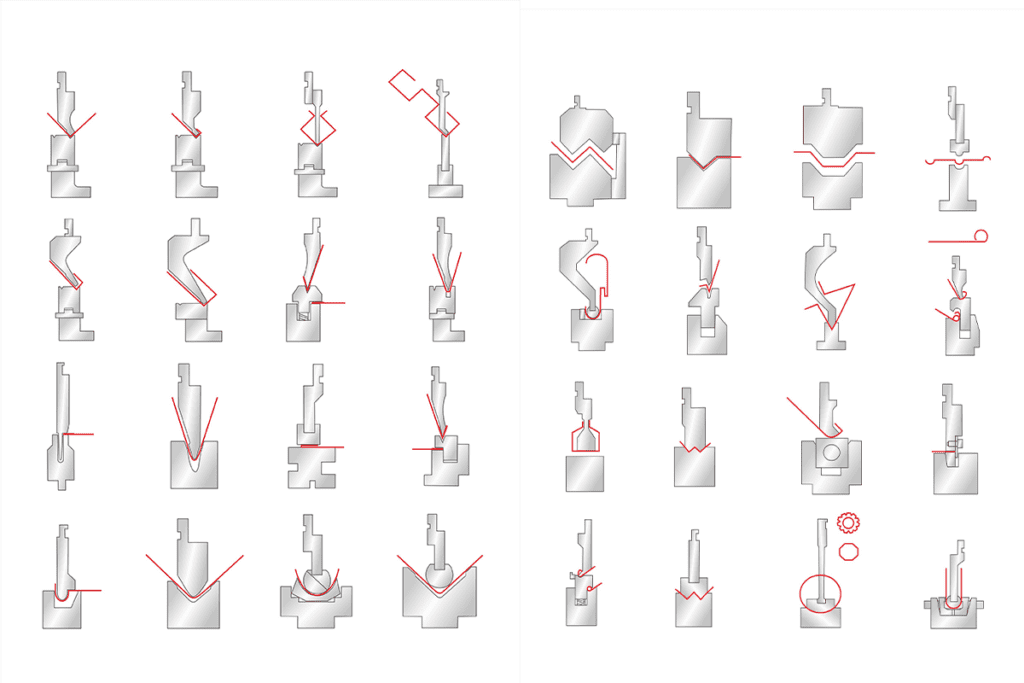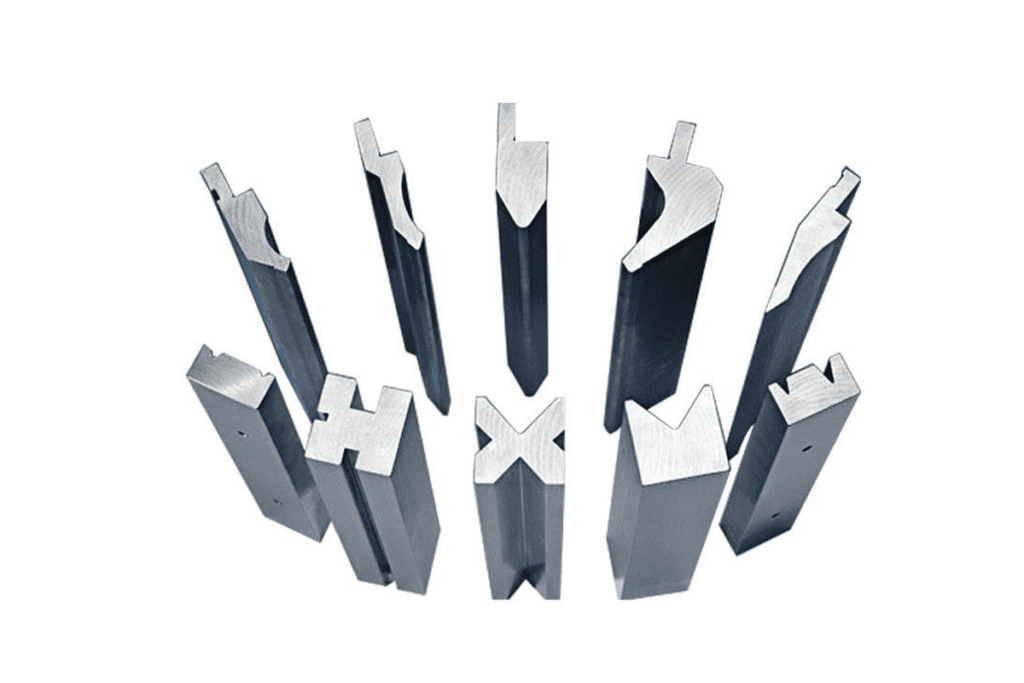Definition and primary function Press brake tooling is a tool used by press brake to form and manufacture sheets. The tooling comprises punch and die, which cooperate together and used for metal sheet punching, forming, and separating. The mold used for forming has a cavity, and the mold used for separation has a cutting edge. In essence, press brake tooling refers to a specialized tool used for press brake, which can transform the blanks into components with specific shapes and sizes under the pressure of the press brake. For beginners, it is essential to know the basic knowledge, such as the interaction between the machine punch and die and metal sheets. This process involves one metal sheet sliding between the two tools: the top tool (punch) descends onto the bottom tool (die) to bend the parts. Importance in the metal bending process Determine the bending form and size accuracy: the shape and size of the tooling can directly determine the bending forms, such as angle, radius of curvature, etc., which is relevant to product quality. Control the bending process: the tooling can fix the metal sheet on a specific location and control its deformation under pressure to keep the bending consistent. Improve production efficiency: through fast-changing tooling, the tooling switching of the different products can be finished in milliseconds, largely shortening the switching period. Prolong the lifespan: the tooling made with abrasive material and dealt with surface treated has several times longer lifespan. Reduce the production cost: use precise tooling can improve productivity and decrease the waste rate caused by tooling consumption. Achieve specific requirements: through CNC technology, the tooling can be bent into any form and meet some particular product manufacturing. Top punch and bottom die: they are the key components to determine the bending shape of the workpiece, which are installed on the upper and lower pressure rods to control the deformation of the bending area of the metal plate. Die shoes: these platforms support and locate the top punch and bottom die. They are connected with the press brake punch to switch the tooling quickly. Bending assistance tool: to help operators finish the bending tasks quickly and easily, sometimes, some assistant tools may be used, such as angle measuring tools and positioning blocks. Quick change system: many modern press brakes are equipped with fast-changing systems, allowing operators to quickly replace the top punch and bottom die to adapt to different bending tasks. Locator pins: they are used to precisely position and fix the workpiece in the die during the bending process. It is essential to locate the locator correctly. Die protectors: install the die protectors on the rim of the die, which can protect the workpiece's acute angle and prolong the die's lifespan. Die sockets: connect the die sockets to the punch interface, which benefits the fast installation and removal of the die. Lubrication systems: distribute the lubrication evenly into the radius of the mold to reduce the workpiece abrasive and burning. Die pads/blocks: these are used to support dowels and help build toolsets. Rigidity is important. Spacers: control the bending depth by keeping the distance of the bending surface consistent. Die drifts: they are used to remove the bending components and can also be used in the setting. Rocker-type die: this type of die, rocker, bends the metal via slides up and down on the metal sheets. Gooseneck dies: gooseneck die features distinctive shape, which is similar to the gooseneck. They are mainly designed for removing protruding edges or flanges on workpieces, making them the ideal choice for bending profiles with deep boxes or high flanges. V die: v shaped die is the most common type of die, which features a shaped groove. It is used to create v-shape bending for the workpiece. The width and depth of the v groove determine the final bending angle and radium. Acute-angle die: these are used to form acute, obtuse, or right-angle bends. The specific design of the die groove can control the bending angle, ensuring the product's final accuracy. Seaming dies: a seaming die is a specific tool for forming seaming on the sheets and pipes. They are paramount to connecting the two metal sheets, especially in applications such as piping systems or metal containers. Combination die: combine the shapes and functions of multiple dies into one die, such as bending and grooving. Hemming dies: transform the flat edges of the workpiece into circular and seaming shapes for finishing. Bead dies: they are used to create circular and semi-circle protruding edges. Draw dies: use tubular draw beads to draw and shape the workpiece to form the shell. Punching die: punch the hole on the workpiece during the bending process. Stripping dies: they are suitable for applications requiring bend allowance release along curved edges. Clinching dies: join separate metal parts by punching one through the other during the bend. U-shaped die: the bending angle ranges from 90°-180°. The efficiency and lifespan of the press brake tooling have an inner connection with the tooling strength and material. The ingredients and handling of the tooling are paramount because of the tremendous pressure and abrasive during the bending process. Importance of high-strength and abrasiveness Press brake tooling withstands the strict pressure during the operation. High intensity ensures the tools can provide the pressure without deformation and breaking. Moreover, abrasive-proof is essential owing to its determination of the user lifespan. The abrasive-proof tool can keep its shape and function for a long time, ensure consistent bending results, and reduce the requirements for changing regularly. Hardened tooling One of the methods to improve the press brake's rigidness and durability is through hardening tooling. The specific material is popular due to its initial rigidness and further hardening ability. For example: Chromium-molybdenum steel: this alloy is known for its toughness and wear resistance, which can achieve a balance between the intensity and durability of press brake, ensuring the tools can handle the heavy-duty bending operation without being prematurely worn. Yasuki Steel: yasuki steel is a high-grade steel usually used for specialized tools and is famous for its superior rigidness and abrasiveness. Its ingredients can keep its sharp edge, making it an ideal choice for precise and bending tasks. Thermally refined tooling Tempering or heat treatment is a process for enhancing the properties of metal tools. By subjecting a metal to controlled heating and cooling cycles, its molecular structure is changed, improving its properties. For example: Carbon steel: after heat treatment, carbon steel exhibits increased strength and wear resistance. The heat treatment process refines the grain structure of the steel, making it stronger and more durable. Carbon steel tools are tempered and resistant to chipping and deformation, ensuring longer tool life and consistent bending results. The operation efficiency of the press brake depends on the tool's quality and also on how the tool is treated and installed. The correct handling and installation can keep the best performance, reduce wear, and prolong the tool's lifespan. The following introduces the slight difference in the handling and installation of tooling: Importance of tooling geometry The geometry of press brake tooling is designed intricately to achieve bending results. The shape, angle, and size of each tooling are essential to ensure the accuracy of the bending process. When handle and install these tools: Sectionalized tooling and its advantages Sectionalized tooling refers to a tooling group being divided into many parts or segments. Sectionalized tooling is not merely long tooling but allows operators to use shorter tool segment combinations to achieve the required length or setting. The advantages are just as follows: The tooling tolerance is essential in manufacturing because it determines the regular operation of the product, beautiful receptacle measuring range, or other physical properties. And here are the main reasons for its importance: Improving part fit and function: the tolerance ensures the parts can cooperate with other components, thus avoiding functional problems and incompatibility. Strengthening the final product outlook: tolerance is beneficial to realize the product's beauty, such as ensuring the parts leveling without apparent interval. Considering reasonable tolerance: the tooling tolerance can allow existence while keeping its function. Interchangeability of parts: the tolerance allows for single components replacement, which is convenient to maintain and repair. Consistency, accuracy, and precision: the definition of tolerance can better control the product’s consistency, accuracy, and precision. Lower the cost: the manufacturer can minimize costly manufacturing errors and rework by pre-defining the tolerance. Press brake tooling is essential in press brake fabrication. Whether for operators, manufacturers, or anyone who participates in metal fabrication, knowing the press brake tooling can significantly improve the accuracy of the bending process, reduce material waste, and generate more benefits. If you need a press brake machine, you can contact us directly. If you want to learn more about the machine tool, you can browse our official website for details. Download the Infographic With High Resolution Stainless Steel BBQ Grill Mesh Stainless Steel BBQ Grill Mesh,Stainless Steel Bbq Grill Mesh Panel,Stainless Steel Grill Mesh,Barbecue Grill Wire Mesh Hebei Yingkang Wire Mesh Product Co.Ltd , https://www.wiremesh-china.comI. Introduction to Press Brake Tooling
II. Press Brake Tooling Components
III. Common Dies Used in Press Brake Tooling

IV. Tooling Strength and Material
V. Handling and Installation of Tooling
VI. Importance of Tooling Tolerances

VII. Conclusion

Stainless steel grill mesh, also known as grates or grids, is the surface on which you place your food while grilling. It's made from stainless steel, a material prized for its durability, resistance to corrosion, and ability to maintain high heat efficiently. Stainless steel meshes come in different shapes (square, round, diamond), sizes, and thicknesses depending on the intended use.
Benefits of Stainless Steel Grill Mesh
1. Durability: Stainless steel is highly resistant to rust and corrosion, making it a long-lasting choice for outdoor use.
2. Heat Retention: It conducts heat well, ensuring that your food cooks evenly and quickly.
3. Ease of Cleaning: Stainless steel surfaces are generally easy to clean, reducing the time and effort needed for post-grilling maintenance.
4. Safety: It's less likely to warp or melt under high heat compared to other materials, reducing the risk of injury or damage.
5. Versatility: It can be used with various types of fuel sources (charcoal, gas) and is suitable for both direct and indirect cooking methods.
Choosing the Right Grill Mesh
- Size and Shape: Select a mesh that fits your grill perfectly to prevent food from falling through. Square and diamond-shaped meshes are common and offer good airflow for even cooking.
- Thickness: Thicker meshes are better at retaining heat but may require more time to preheat. Thinner meshes cook faster but might not retain heat as effectively.
- Material Quality: Look for high-quality stainless steel that has a protective coating to prevent rust and improve longevity.
Maintenance Tips
- Regular Cleaning: After each use, clean the mesh with a wire brush or a grill cleaning tool to remove any residue.
- Seasoning: For new or heavily used grills, consider seasoning the mesh to create a non-stick surface, enhancing food release and flavor retention.
- Storage: Store the grill mesh in a dry place when not in use to prevent rust.
Conclusion
Choosing a stainless steel BBQ grill mesh ensures a reliable, durable, and efficient grilling experience. With proper care and maintenance, this investment can last for many years, providing countless meals for family and friends.
Stainless steel BBQ grill mesh is an essential component of a high-quality outdoor cooking experience. Here's some information you might find useful:What is Stainless Steel BBQ Grill Mesh?